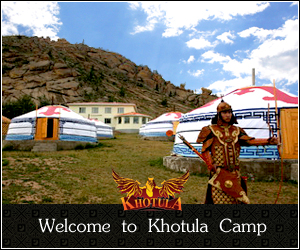Era of Genghis Khan
Temuujin, the first-born son of Yesukhei and Oulun, was born in 1162 at a place named Deluun Boldog, located on the upper reaches of the Onon river. The largest Mongolian tribes at that time were the Khamag (Whole) Mongols, The Khereid, Merged, Naiman, Tatars and others. The basic wealth of the Mongolian cattle-raising tribes consisted of sheep, goats, horses and cattle.
There were a few camels, bred chiefly by the Naiman. The horse was a means of locomotion in everyday life and a faithful friend in battle, on the march and in hunting. When Temuujin was nine years old, his father Yesukhei was poisoned by Tatars, leaving his widow Oulun in misery with their four sons. Nevertheless, Oulun managed to educate her sons in accordance with their noble status. Before starting his struggle for power over other tribes, Temuujin applied for support from the Khereid tribe’s chieftain Wan Tooril, his father Yesukhei’s friend. With the help of Wan Tooril and Jamukha, Temuujin defeated the Mergid, and under the banner of the Khamag Mongols, unified the Mongolian tribes of Taichuud and Jurhen. In 1189 Temuujin was proclaimed the Khaan of the Khamag Mongols by the Ikh Khuraldai (General Assembly). The young ruler of the Khamag Mongols went ahead with the organization of the state’s administrative structure and strengthening of its military forces. If efforts to unite and restore his rule of the Khamag Mongol took 15 years after his fathers’ death, Temuujin knew it would then take another 17 years of fighting. Temuujin was painfully aware that without establishing a united state of Mongols it would not be possible for the Mongols to survive among their hostile neighbors.
In 555 B.C. the Jujan Khanata was defeated by the Altai Turks and for almost five centuries they were subjugated by the Turkic people – The Turks, Uigur and Kyrgyz. During the period of communication of Turkic people on Mongolian territory, the native Mongols live in the eastern and north-eastern regions of Mongolia, forming small separate khanates. Under conditions of feudal division and internal strife the khuree, or ring-shaped disposition of families, was widely used as a means of defence against surprise attack. Vestiges of the clan system, customs and religious beliefs (Shamanism) were retained by the Mongols of that time even after the feudal mode of production became predominant. At the beginning of the eleventh century, Khamag Mongols had emerged in central Mongolia as the leading clan of a loose federation. The Khamag Mongol ulus (state) was ruled by Khabul khan, one of whose most influential successors was his grandson Yesuhkei-baatar. He ruled over the largest of the Khamag Mongol tribes – the Taichuud.















